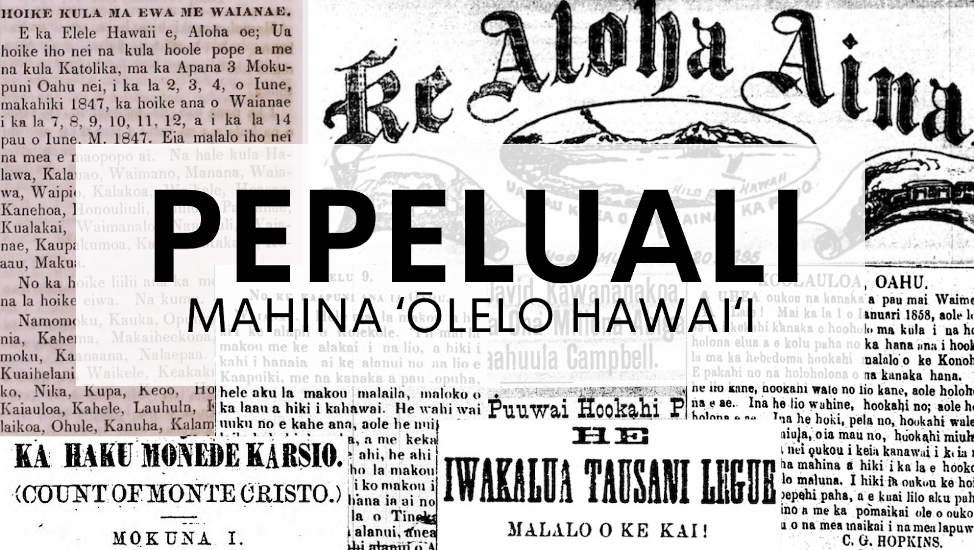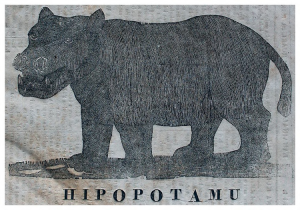2021 Mahina ʻŌlelo Hawaii
January 29, 2021 Kawena Komeiji
Aloha Pepeluali kākou! ʻO Pepeluali ka mahina ʻōlelo Hawaiʻi. No laila, e nānā kākou i kekahi waihona nui o ka ʻōlelo Hawaiʻi, ʻo ia hoʻi ka ʻohina nūpepa ʻōlelo Hawaiʻi.
I ka makahiki 1834 ma ke kula nui ʻo Lahainaluna i Maui, ua paʻi ʻia ka nūpepa mua e nā kumu misionari, i mea i hōʻike ʻia ai ka hoʻolaha ʻana o ka nū hou. ʻO ia poʻe haumāna, ʻo ia nō nā mea kākau Hawaiʻi kaulana e like me Samuela Kamakau a me Davida Malo. Ua kapa ʻia ka nūpepa i Ka Lama Hawaii, a ua paʻi ʻia nā mea Baibala a me ka nū hou. Akā naʻe, ua kākau ʻia ka ʻaoʻao hope e nā haumāna. A ua paʻi ʻia ka ʻaoʻao mua me ka ʻike e pili ana i ka holoholona haole. Kupanaha nō kēia mau holoholona i nā kānaka Hawaiʻi, no ka mea, ʻaʻole i ʻike ʻia ma Hawaiʻi nei!

Piʻi aʻela ka hoihoi o nā Hawaiʻi i ka heluhelu, a ua lilo ka lāhui Hawaiʻi i lāhui heluhelu a kākau. A ʻo ia nō ke kumu a ka mōʻī ʻo Kauikeaouli e kūkala aku ai, “He aupuni palapala koʻu.” Mai ka makahiki 1834 a i ka makahiki 1948, ua paʻi ʻia nā ʻaoʻao nūpepa ma kahi o nā kaukani haneli me nā moʻolelo Hawaiʻi (Lonoikamakahiki, Kamapuaʻa, Kaʻehuikiopuʻuloa, Hiʻiakaikapoliopele), nā moʻolelo haole (He Kaʻao Arabia, Ka Haku Monede Kariso, Iwakalua Tausani Legue Ma Lalo o ke Kai), ka nū hou, nā leka, a pēlā wale aku.
E nānā i nā nūpepa ʻōlelo Hawaiʻi ma Papakilo: www.papakilodatabase.com
No ka mahina ʻo Pepeluali, e kau ʻia ka ʻōlelo noʻeau o ka lā ma ko mākou Instagram. Inā hoihoi, e ʻimi ma Instagram – @uhwolibrary!
ʻŌlelo Pelekania
February is Hawaiian language month so let’s look at one of the biggest repositories of Hawaiian language documents – the Hawaiian language newspapers!
The newspapers began publication in 1834 at Lahainaluna Seminary School. The missionary teachers there wanted to show students how information circulated. These students would later become famous writers and historians, like Samuel Kamakau and David Malo. The newspaper was called, Ka Lama Hawaii, and contained news from different missionaries and Bible studies, however; the last page was often written by the students of Lahinaluna. On the first page, a picture and information about foreign animals was printed. You can imagine the surprise of Hawaiians when they saw a picture of these animals that had never been seen before in Hawaiʻi!

This piqued people’s interest in reading and the lāhui Hawaiʻi would eventually become one of the most literate nations in the world. This led Kauikeaouli (Kamehameha III) to proclaim, “He aupuni palapala koʻu”, which translates to “Mine is a literate nation”. From 1834 to 1948, more than a hundred thousand pages were printed. These pages contain moʻolelo from Hawaiʻi (Lonoikamakahiki, Kamapuaʻa, Kaʻehuikiopuʻuloa, Hiʻiakaikapoliopele, etc.), translated moʻolelo from foreign places (Arabian Nights, Count of Monte Cristo, Twenty-thousand Leagues Under the Sea, etc.), news, letters, and more.
You can look at some of the Hawaiian language newspapers online at Papakilo: www.papakilodatabase.com
For the month of February, we’ll be posting up an ʻōlelo noʻeau of the day on our Instagram. Find us on Instagram – @uhwolibrary!
Additional Resources
- Moʻokini, Esther. ʻŌlelo Makuahine: Hawaiian Language References. Honolulu: Hawaiian Historical Society, 1974.
- Nupepa Hawaii (blog): https://nupepa-hawaii.com
- Nogelmeier, Puakea. Mai Paʻa i ka Leo: Historical Voice in Hawaiian Primary Materials: Looking Forward and Listening Back. Honolulu: Bishop Museum Press, 2010.
- Silva, Noenoe. The Power of the Steel-Tipped Pen: Reconstructing Native Hawaiian Intellectual History. Durham: Duke University Press, 2017.


